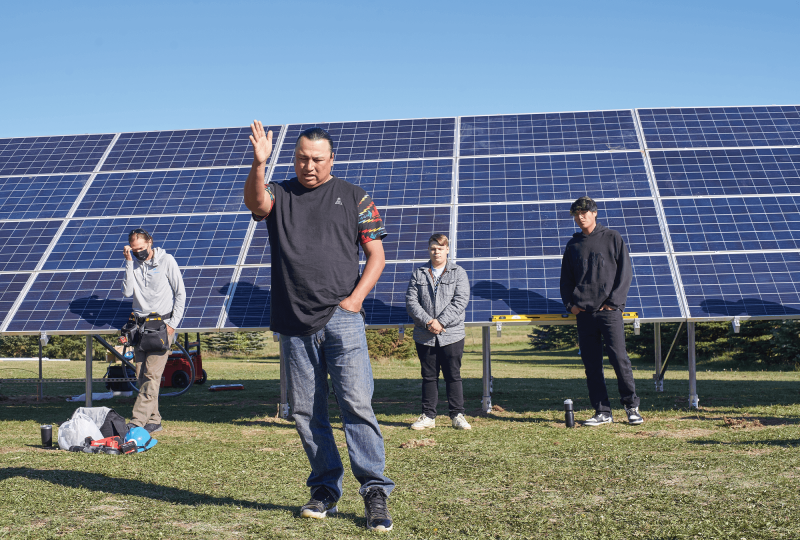IN 1876, LAKOTA SIOUX rode on horseback from South Dakota to Montana Territory to help the Northern Cheyenne at the Battle of the Little Bighorn in one of the most important actions of the Great Sioux War.
The battle was inevitable. The rights promised through the Second Treaty of Fort Laramie, which gave the Sioux and Arapaho possession of the Dakota Territory, were being ignored. White miners had come to settle on part of the land that was sacred to the Lakota Sioux. The U.S. government ordered the Indigenous communities to return to their designated reservations. Instead of complying, they banded together as an act of resistance. Led by Lakota Sioux Chief Sitting Bull, the Indigenous resistance grew several thousand in number and ultimately defeated Lt. Colonel George Custer and the 7th Calvary—one of the worst U.S. army defeats during the Plains Wars.
Nearly 150 years later, members of the Sioux and Northern Cheyenne have joined forces once again to defend themselves against a new threat to their communal life: fossil fuels.
Chéri Smith, a descendant of the Mi’kmaq Nation of Northern Maine and the Canadian Maritimes, learned about the Northern Cheyenne nation’s long battle with Arch Coal, which in the 1970s began attempts to control the nation’s mineral rights. The 440,000-acre Northern Cheyenne reservation sits atop the largest remaining seam of low-sulfur, strip-minable coal in the country, Smith said. Arch Coal sought to mine 1.3 billion pounds of coal from Otter Creek, which runs through Northern Cheyenne territory, to export to Asian markets. The coal company’s plan was to carve a swath from the Northern Cheyenne reservation all the way to the Lummi Nation’s homeland in Washington state, just south of the U.S.-Canada border, Smith said.
The long struggle with Arch Coal inspired Smith to found the Covenant Tribal Solar Initiative, recently relaunched as the Indigenized Energy Initiative (IEI), where she is now the managing director.
Otto Braided Hair Jr. and his daughter Vanessa Braided Hair founded ecoCheyenne in 2012 to raise awareness of the potential ramifications of Arch Coal establishing a coal mine on the reservation. Through their grassroots efforts and help from numerous volunteers, they educated and informed tribal members about the dangers of fossil fuels. Despite multiple attempts by Arch Coal, the nation members fought to keep the coal in the ground, vowing to protect their land. In 2016, the tribe passed several resolutions that paved the way for renewable energy and prompted Arch Coal to withdraw from the 40-year battle.
The preexisting partnership between the Northern Cheyenne and the Sioux was strengthened by the Dakota Access Pipeline protests that brought together tribes across the country to stop construction on the 1,172-mile underground oil pipeline. Their work eventually led to the formation of a formalized team of solar experts, both Indigenous and non-Indigenous, who were focused on bolstering the empowerment of Indigenous peoples of the Great Plains through solar energy. Today, Indigenized Energy is building a self-sufficient green workforce and creating a new kind of Indigenous sovereignty.
Led by Smith and in collaboration with SolarCity, which is now Tesla Solar, the Northern Cheyenne nation completed its first solar panel demonstration on the home of tribal member Elsie WeaselBear. Smith said that WeaselBear, despite being an elder and largely unfamiliar with the technology, accepted the system being installed on her home. “She marched her little self into the tribal capital chambers with her electric bill the first month that the solar system had been fully operational,” Smith said. Before the installation of the solar panels, WeaselBear’s monthly electric bill had been close to $600. After the solar panel installation, her bill dropped to $32. According to Smith, this helped the council see solar power’s potential and convinced the body to fully support projects across the reservation.
‘A new way of life that honors the old’
WHEN EUROPEAN SETTLERS first came to North America, Indigenous people taught them how to live on the unfamiliar land, grow food, and build homes, said Cody Two Bears, a co-founder of IEI and a well-known #NoDAPL (No Dakota Access Pipeline) movement activist. “When [European settlers] didn’t need us anymore, the thought was to divide and conquer [the Indigenous peoples].”
In many instances in American history, Two Bears said, settlers drove Indigenous peoples from their land, which prevented them from preserving and practicing their land-sustaining rituals. Today, amid intensifying natural disasters, extreme heat, and sea-level rise, the Western world is turning back to Indigenous knowledge, recognizing that it is those who have tended to the earth the longest who “understand what it takes to live here and take care of this land,” Two Bears said.
When Two Bears was 26, he became the youngest person ever elected to the tribal council of the Standing Rock Sioux. After being a central voice in the #NoDAPL protest, Two Bears, now 37, saw a new path forward with solar energy and IEI. By the end of 2017, Two Bears had initiated the effort to develop solar on Standing Rock Sioux land and had successfully sought donations to develop the largest—300 kilowatts—solar farm in the state of North Dakota, just three miles from the Dakota Access Pipeline. Combining cutting-edge science and technology with Indigenous customs is how we “learn a new way of life that honors the old way,” said Two Bears, paraphrasing advisory board member Chief Henry Red Cloud. Two Bears said that relaunching the organization as the Indigenized Energy Initiative “better represents who we are: Indigenous people taking back our power.”
crawford_3.png

Dr. David Riley came to the effort while he was on the faculty of Penn State University, experimenting with alternative building methods. He had been approached by the nonprofit Red Feather Development Group, based in Washington state, which expressed interest in housing strategies that would be suitable for Indigenous communities. Many of the members Riley and the nonprofit worked with lived in housing provided by the Department of Housing and Urban Development. The homes were built to be economical but not very energy efficient. Tribal community members “ended up spending hundreds of dollars on high energy costs,” Riley said.
In the early days, Riley explained, the homes were made by hand, but in later years the homes became modular. The nonprofit experimented with straw-bale construction, which can provide good insulation and structural support, and was ultimately able to build six homes and community buildings. Toward the end of those projects, solar power was starting to be incorporated in building designs.
Riley worked on demonstration projects on three reservations with Red Feather. “That was about when I realized that moving from one reservation to the next every year wasn’t really going to accomplish much,” he said. His third and final project was with the Northern Cheyenne reservation. In 2000, the Northern Cheyenne nation invited the group to develop a more long-term relationship. Now, Riley is a part of IEI’s core team, focusing on strategic planning and partnerships to secure funding for the development of solar projects.
Riley admits that, early in his career, he was not dialed into the ecological impacts of buildings and construction. But working with Red Feather helped him understand the potential for solar energy. He saw the prices of solar panels drop due to more efficient technology and better financing mechanisms and learned about the need to have a new kind of electric grid as our reliance on fossil fuels becomes increasingly unsustainable. As energy demand rose nationally due to urbanization, population growth, and industrial activity, “it was evident that solar was going to cross the line and be the most cost-effective way to go,” said Riley. But as technology advanced, education on its benefits didn’t. “That’s where, as a teacher, I felt like I could contribute,” said Riley.
In 2021, the Indigenized Energy Initiative embarked on two groundbreaking solar installation demonstrations projects. The first, a 10-kilowatt solar system, began in June 2021 on the Northern Cheyenne reservation at the Muddy Hall community building. The second started in September 2021 at the family home of four Standing Rock tribal elders. Participants at both demonstrations received multiple days of training that included learning system design, installation management, safety, and more. IEI invited community members to the demonstration and offered full support, such as compensating participants if they took time off work to take part in the solar demonstration. Some community members were ultimately hired by IEI to serve as solar representatives in their own communities, helping to maintain systems and educating community members on the benefits of solar power. Others were hired by other solar companies within the region.
Solar projects look different depending upon the tribe’s needs. Some tribes may be looking to develop a large-scale solar farm where excess energy could be sold to a utility company as a revenue stream for the reservation. Others are focused on providing solar energy to individual homes and buildings to help lower energy costs. Regardless, many community members are starting to see how vulnerable their current energy infrastructure is as climate change spurs hurricanes, winter storms, and sea-level rise. Solar provides a source of emergency power in these situations, which is of critical concern to health care centers and hospitals.
The new federal infrastructure bill enacted last fall has made a significant amount of funding available to Indigenous communities looking to enter the renewable energy space. IEI is helping the Indigenous community take full advantage of the $11 billion earmarked for infrastructure projects in Indigenous communities. For the ongoing White River Community Solar Project, for instance, the Department of Energy will match all donations up to $400,000.
A rejuvenation of identity
INDIGENIZED ENERGY ADVISORY board member Chief Henry Red Cloud is a pioneer in solar energy on the Oglala Lakota Nation reservation. Two Bears describes Red Cloud as “the OG of solar,” as he has been training people and leading solar demonstration projects for more than 20 years. IEI has an active partnership with Red Cloud’s nonprofit, Red Cloud Renewable. Red Cloud calls trainees “solar warriors,” as some of them have an uphill battle in advocating for solar in their community. What’s powerful about these warriors, Riley said, “is that it is a community of individuals who’ve realized there’s a real opportunity there.” The organization is also exploring other forms of renewable energy, including wind. “We’ve advised tribes on some proposed wind projects and absolutely have the capabilities,” Riley said.
crawford_1.png

But the main goal of IEI is to help tribes develop financially vibrant economic systems through renewable energy. Riley envisions a revolving fund where tribes would accumulate revenue that would then go back into building more renewable energy projects. In addition, Riley sees using philanthropic dollars to help further investments in solar and expand Indigenous resources to maintain their own projects.
The Midwest and the Great Plains face harsh weather conditions, and reservations tend to be in very remote areas. “[In the past, one of the few] options for having economic opportunity was to buy into fossil fuels,” Daniel East, a co-creator of IEI, explained. The renewable energy space is not exempt from capitalistic greed and extraction. “In the corporate solar industry world, there is an urgency to install as many kilowatts as possible in order to make the most money,” East said. Despite solar being a renewable energy source, exploitation and monopolization can still happen. IEI is pushing to help tribes find their own economies of scale. “Growth comes from creating thoughtful ways of approach to help [tribes] realize their visions for how they want to approach this work,” East said. In all of this, there is an opportunity for healing and independence. Even more important, there is room for the rejuvenation of identity.
East talked about the Indigenous belief that energy—one of the largest industries on the planet and one of the biggest contributors to environmental harm—is linked to the same energy or spirit in all living beings. If humans believe they can dominate and exploit that energy, our relationship with energy will remain broken. “I believe that finding the right relationship to energy is not only healing for these tribes, but it’s healing for everyone,” East said.
Exploitative industries have been putting pressure on marginalized communities for centuries. “Our focus is on what comes next,” Smith said. The Indigenized Energy Initiative seeks to work with Indigenous nations to develop the tools and the skills needed to break free from historical constraints such as discriminatory energy pricing and replace it with “self-determiNation.”
“Having an economy based on things that are actually in line with our Native ethos and value systems and can employ Native people is how we break free and truly become sovereign again,” Smith said. “All of that leads to a restoration of self-reliance and hope.”

Got something to say about what you're reading? We value your feedback!

